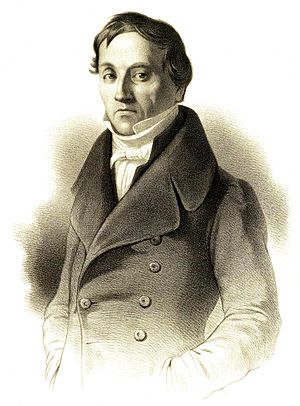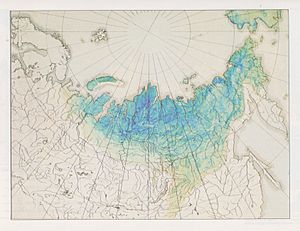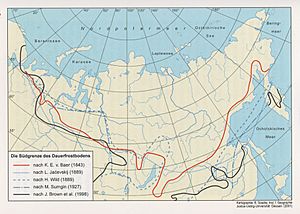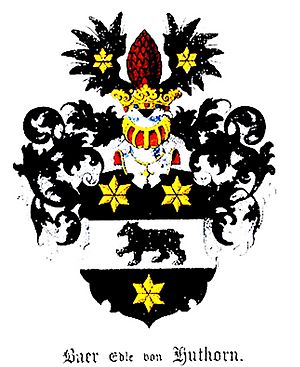Karl Ernst von Baer facts for kids
Quick facts for kids
Ritter
Karl Ernst von Baer
|
|
|---|---|
 |
|
| Born | 28 February [O.S. 17] 1792 Piep, Kreis Jerwen, Governorate of Estonia, Russian Empire
(in present-day Piibe, Lääne-Viru County, Estonia) |
| Died | 28 November [O.S. 16 November] 1876 (aged 84) |
| Nationality | Baltic German |
| Alma mater | Imperial University of Dorpat |
| Known for |
|
| Scientific career | |
| Fields | Biology, embryology, geology, meteorology, geography |
| Institutions | Imperial University of Dorpat, University of Königsberg, Russian Academy of Sciences, Russian Geographical Society |
Karl Ernst von Baer (born February 28, 1792 – died November 28, 1876) was an important Baltic German scientist and explorer. He is often called the "father of embryology". This is the study of how living things develop before they are born or hatch.
Baer was also a naturalist, biologist, geologist, meteorologist, and geographer. He was a member of the Russian Academy of Sciences. He also helped start the Russian Geographical Society. He was one of the most famous Baltic German scientists of his time.
Contents
Life Story
Karl Ernst von Baer was born into a noble family in Estonia. He spent his early childhood at Lasila manor. He went to school in Reval (now Tallinn) and then to the Imperial University of Dorpat (now Tartu).
In 1812, he went to Riga to help people after Napoleon's armies attacked the city. He realized his education wasn't enough to help the sick and wounded. After graduating, he decided to study more abroad.
He continued his studies in Berlin, Vienna, and Würzburg. In Würzburg, he learned about the new field of embryology.
In 1817, Baer became a professor at Königsberg University. He taught zoology and later anatomy. In 1834, he moved to St Petersburg and joined the St Petersburg Academy of Sciences. There, he studied anatomy, ichthyology (fish), ethnography (cultures), anthropology (humans), and geography.
While in Russia, Baer did a lot of field research. He explored the island of Novaya Zemlya in the Arctic. He spent his last years in Dorpat, where he became a critic of Charles Darwin's ideas.
Major Discoveries
Embryology: How Life Develops
Baer studied how animals develop from an early stage. He discovered the blastula stage of development. This is an early stage where the embryo is a hollow ball of cells. He also found the notochord, a rod-like structure that helps form the backbone.
He helped describe the "germ layer theory" of development. This theory explains that an embryo forms from three main layers of cells. These layers are the ectoderm, mesoderm, and endoderm. Each layer develops into different parts of the body. This idea laid the foundation for comparative embryology.
In 1826, Baer made a huge discovery: he found the mammalian ovum (egg cell). This was the first time anyone had seen a mammal's egg. In 1827, he was the first to observe human ova.
Baer also came up with "Baer's laws of embryology":
- General features of a group (like all vertebrates) appear before specific features (like a bird's beak).
- General body structures form before the most specific parts appear.
- An embryo doesn't become like other forms. Instead, it becomes more and more different from them.
- The embryo of a more complex animal never looks like the adult form of a simpler animal. It only looks like the simpler animal's embryo.
Permafrost Research: Frozen Ground
Baer was also very interested in the geography of northern Russia. He explored Novaya Zemlya in 1837. In these arctic areas, he studied permafrost. Permafrost is ground that stays frozen for at least two years. He also collected different types of plants and animals.
Baer was one of the first scientists to study permafrost in detail. He realized how important it was to understand this frozen ground. He even wrote the world's first textbook on permafrost in 1842/43. This book was lost for over 150 years. It was finally found and published in 2001.
His observations on permafrost distribution are still mostly correct today. He described different types of permafrost. He also explained how permafrost forms and changes over time. His work laid the foundation for how we understand permafrost today.
Evolution: How Species Change
Baer studied how different animal embryos develop. He believed that species could change over time. However, he later disagreed with Charles Darwin's theory of natural selection. Natural selection is the idea that living things with helpful traits are more likely to survive and reproduce.
Darwin himself recognized Baer's contributions. He noted that Baer believed different species came from a single parent form. Baer also studied how animals perceive time.
Awards and Honors
Karl Ernst von Baer received many awards and honors during his life.
- In 1849, he became an honorary member of the American Academy of Arts and Sciences.
- In 1850, he was elected a foreign member of the Royal Swedish Academy of Sciences.
- He was president of the Estonian Naturalists' Society from 1869 to 1876.
- He helped start and was the first president of the Russian Entomological Society.
- In 1875, he became a foreign member of the Royal Netherlands Academy of Arts and Sciences.
Legacy

There are statues honoring Karl Ernst von Baer in Tartu, Estonia, and at Lasila manor. There is also a statue at the Zoological Museum in St Petersburg, Russia. In Tartu, his former home is now the Baer House, which is also a museum.
Before Estonia started using the euro, his picture was on the 2-kroon bank note. An island in the Kara Sea, Baer Island, is named after him. A type of duck, Baer's pochard, is also named in his honor.
Works
- Karl Ernst von Baer, Gregor von Helmersen. Beiträge zur Kenntniss des Russischen Reiches und der angränzenden Länder Asiens, 2 vols. Kaiserlichen Akademie der Wissenschaften, 1839.
- Karl Ernst von Baer, Welche Auffassung der lebenden Natur ist die richtige? Berlin, 1862
See also
 In Spanish: Karl Ernst von Baer para niños
In Spanish: Karl Ernst von Baer para niños





